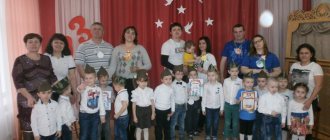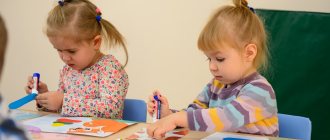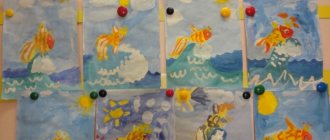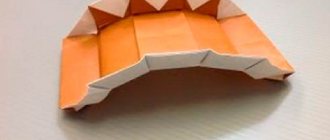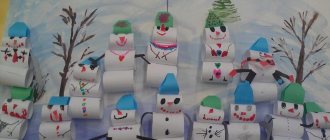Ekaterina Puchkina
Schemes and card index of buildings based on Lego construction
Card index of Lego building games.
1. Where is Matryoshka?
Visual material: buildings made from Lego (house, bed, car, toy matryoshka
Progress of the game: the teacher moves the Matryoshka in the building : puts it on the roof, puts it on the bed, hides it behind the house, behind the car.
The children explain where Matryoshka is - Matryoshka is standing on the roof.
2. Fourth wheel
Goal: to develop attention, intelligence, evidence-based speech
Schemes for construction sets for children of senior preschool age
Publications on the topic:
"Preschool Worker's Day" Scenario for a holiday for children of senior preschool age “Day of Preschool Worker” Scenario for a holiday for children of senior preschool age. The hall is decorated with balloons. Ved: Hello, dears.
Entertainment script “Come visit us!” for the Day of Preschool Worker for children of senior preschool age “Come visit us!” Entertainment script for “Preschool Worker's Day” for children of senior preschool age. Characters:.
Formation of ideas about the family in children of senior preschool age in the context of the Federal State Educational Standard The most specific characteristic of an individual is the system of her relations to the world around her and the characteristics of her behavior in the future.
Summary of educational activities on modeling using Lego constructors with children of senior preschool age Katkova Anna Nikolaevna, teacher Age group: 6 - 7 years Topic: “Acquaintance with space through the LEGO constructor” Type of construction:.
Consultation for parents “The benefits of Lego for preschool children” Every child is unique, and everyone is born with abilities that can and should be developed. Preschool children have great desire.
Consultation for parents “What are the benefits of the LEGO construction set for preschool children?” Consultation for parents What are the benefits of the LEGO construction set for preschool children “LEGO is a necessary game!” The most famous in the world.
Presentation “Finger gymnastics for young children with construction items” Finger gymnastics for young children is used to develop fine motor skills of the hand and fingers. Learn to repeat after an adult.
Development of spatial thinking in children of senior preschool age using the Lego constructor. The relevance of this work is due to the need for a more in-depth study of the issue regarding child development using non.
Recommendations for parents on choosing a construction set for children of senior preschool age Recommendations for parents on choosing a construction set for children of senior preschool age. Man is a creator. This is his main quality.
Schemes for examination of children Schemes for examination of children Examination of children with FFDD Mental development: - direct counting; - countdown; -counting operations; - generalizing words;
Organization of construction games in the second junior group
Thus, the basis of construction-constructive play is an activity in which children reflect the life around them in a variety of buildings using various materials and playful actions with them.
Educational and developmental influence
of construction-constructive games on a child
Construction-constructive games contribute to the child’s development of:
- creativity,
- constructive thinking,
- spatial imagination,
- fantasies,
- create different models,
- knowledge of color, size, shape.
The concept and content of construction games contain one or another mental task, the solution of which requires preliminary thinking: what to do, what material is needed, in what sequence the construction should take place.
In the process of construction-constructive games, an adult teaches children to observe, distinguish, compare, remember and reproduce construction techniques, and focus on the sequence of actions. Children learn how to make a building, learn to plan the work, presenting it as a whole, and carry out analysis and synthesis of the building.
Construction games promote positive relationships between peers. Construction and construction games are of a group or collective nature and therefore contribute to the development of mutual understanding, teach them to be attentive to other children, and communicate with peers and adults. In addition, children noticeably develop an interest in technology and the ability to finish a job; see the result of collective work, its benefits.
Construction-constructive games are an opportunity to master a precise vocabulary (speech is enriched), expressing the names of geometric bodies, spatial relationships: high - low, right - left, up - down, long - short, etc.
In construction games, a child’s varied motor activity is demonstrated and coordination of movements develops. Of particular importance is the development of small muscles of the hand and the eye. By constructing buildings from large parts, children make the physical efforts available to them, show endurance and endurance.
Thus,
construction games significantly influence the development of a preschool child.
Conditions for playing with building materials
For construction games, special conditions must be created: the availability of the necessary building material. The following types of building materials are distinguished:
- natural (sand, snow);
- utility room (boards, boxes, boxes, etc.);
- specially created (floor, tabletop building material, Lego-type sets; mosaic:
- geometric,
- circular,
- small
It is necessary to provide a time during the day and a place for these games. The material should be varied, attractively designed, sustainable, and appropriate for the age of the children.
- It is better to store small building materials and construction sets in a closet or on a rack accessible to children.
- Large building materials are located away from the tables, since construction games require more space, as children often unite in groups of several people, talk, consult, move parts, and make changes to buildings.
Typically, a permanent place is allocated for storing building materials - a construction corner. The parts are folded neatly, steadily, in order to comply with safety regulations. Young children take the material and put it away after playing with the help of an adult, and older preschoolers do it all on their own.
Children must be introduced to the procedure for storing building materials, require careful handling and respect for buildings.
To play around with buildings, it is necessary to create conditions by selecting small toys (cars, figurines of animals, people, etc.). An important condition for construction games is their theme
.
For example: in the second younger group (3-4 years)
– gates, paths, truck, furniture for dolls, houses, turrets, garage, train, fences for animals, birds, etc.;
in the middle group (4-5 years old)
- two-story houses, a steamboat, a slide with a ramp, a garage for two cars, a bridge, a railroad and a train, etc.;
in the older group (5-6 years old)
- an airplane, various cars, a street, a kindergarten, a zoo, various steamships, pedestrian and automobile bridges, etc.;
in the preparatory group (6-7 years old)
- fairy-tale houses, river and railway stations, theatre, multi-storey buildings, various airplanes, metro, a tower based on a fairy tale, etc.
Guidance of construction and construction games with building materials
Children really love construction and construction games . Moreover, these games captivate both boys and girls equally. In domestic preschool pedagogy, a number of studies have been devoted to the methodology of developing constructive skills in children (E. A. Flerina, Z. V. Lishtvan, A. N. Davidchuk, L. A. Paramonova). The main idea of this technique is to lead the child from imitating the actions of an adult to independently solving constructive problems of increasing difficulty.
Children acquire basic skills:
- during the learning process in design classes;
- in joint activities with an adult;
- and then transfer them, transforming, supplementing and varying them into independent construction games.
To develop children's interest in these games, the teacher uses various techniques:
Construction in kindergarten according to Federal State Educational Standards
Developing children's imagination and creativity through the use of various types of construction.
The goal of training is not only to master basic manual labor skills, but also to develop the mental and aesthetic education of the child, the development of his creative and technical abilities Objectives: 1. To create in children an interest in design activities and a desire to experiment. 2. Develop imagination, the ability to see the unusual in ordinary objects, develop fine motor skills, thinking, and attention. 3. Develop children's artistic and creative abilities. 4. Develop aesthetic perception of artistic taste. 5. Develop the ability for self-analysis of designs, diagrams, and content of your toy sketches. 6. Teach children various techniques for transforming paper, fabric, natural and waste materials. 7. Learn to create joint decorative structures from different materials. 8. Teach how to construct from a variety of construction sets that have different methods of fastening. Develop installation and dismantling skills. Construction is a form of child activity that develops spatial thinking, allows him to foresee future results, provides an opportunity for the development of creativity, and enriches speech. Children's construction refers to an activity in which children create a variety of play crafts (toys, buildings) from various materials. Types of construction in kindergarten: Depending on what material children use to create their buildings and structures, they are distinguished: Construction from building materials: There are many sets for all age groups of kindergarten. When I go for a walk, I use sand sets; in winter, I use shovels and buckets for building fortresses and slides.
In the group we use ready-made board games for design and construction: various mosaics, lacing, small wooden cubes, paper constructor, tangram, etc. d. Games on the floor: modular cubes, large wooden, plastic cubes, sets: “Farm”, “Railroad”, etc., they are used as an independent type of material for construction, can be used together with each other (cubes and construction set )
Construction from paper, cardboard, boxes (waste material): Before making a toy, you need to prepare the material (paper, boxes, foam plastic, plastic spoons, forks, plates, etc.). In my work I actively use origami (paper construction) - the craft can be used both as an independent toy and as a holiday gift (card for the New Year, March 8, etc.)
The whole process requires the ability to measure, fold paper correctly, and use scissors. All this is much more complicated than constructing buildings by assembling them from separate ready-made forms. When working with children, I also use waste materials, such as spoons, plates, boxes, etc. By connecting parts together with glue or plasticine (it is possible to connect different materials with each other), children get interesting toys. Construction from natural materials: Natural materials can be used as construction materials for children’s games, starting from the second youngest group. This is, first of all, sand, snow, and water. From raw sand, children build a road, a house, a slide using molds (sandboxes) - pies, etc. At an older age, children freeze colored water, preparing colored pieces of ice with which to decorate the area. They make a slide, a house, a snowman, and animal figurines from snow.
Using natural material in my work, I introduce children to its properties, they learn to fill their free time with interesting activities. They learn that sand is free-flowing, but you can sculpt from raw sand, water can be poured into different dishes, and in the cold it freezes, etc. From branches, bark, leaves, chestnuts, cones, nut shells, straw, acorns, seeds etc., you can create entire compositions. By creating forest animals and trees, we immerse children in the world of play. The peculiarity of crafts made from this material is that its natural shape is used. Quality and expressiveness are achieved by the ability to notice similarities in natural materials with objects of reality, and to enhance this similarity and expressiveness by additional processing using tools. This activity is especially important for the development of imagination in a child. The list of different types of construction in kindergarten shows that each of them has its own characteristics. However, the basics of activity are the same: in each, the child reflects objects of the surrounding world, creates a material product, the result of children's activity is intended mainly for practical use.
We recommend watching:
Development of creative abilities of children of senior preschool age Construction for senior preschoolers Do-it-yourself Kuvadka doll for children Summary of a design lesson on the topic “Gzhel”. Preparatory group
Similar articles:
Children's aggression. What to do?
Independent activity of children in the younger group according to the Federal State Educational Standard during a walk
How to take into account the child’s temperament in the process of teaching activities
Methods for early teaching children mathematics
Maria Montessori's method of early childhood development

